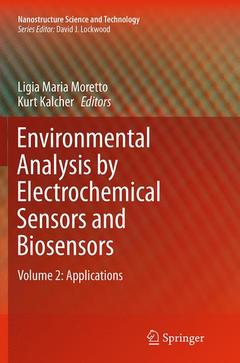Environmental Analysis by Electrochemical Sensors and Biosensors, 2015 Applications Nanostructure Science and Technology Series
Coordonnateurs : Moretto Ligia Maria, Kalcher Kurt

Part 1. Sensors for Measurement of Global Parameters.- Chapter 1. Chemical Oxygen Demand.- Chapter 2. Biochemical Oxygen Demand BOD.- Chapter 3. Total Organic Carbon (TOC).- Chapter 4. Dissolved Oxygen.- Chapter 5. pH Measurements.- Part 2. Sensors and Biosensors for Inorganic Compounds of Environmental Importance.- Chapter 6. Metals.- Chapter 7. Non-Metal Inorganic Ions and Molecules.- Chapter 8. Electroanalysis and Chemical Speciation.- Chapter 9. Nanoparticles-Emerging Contaminants.- Part 3. Sensors and Biosensors for Organic Compounds of Environmental Importance.- Chapter 10. Pharmaceuticals and Personal Care Products.- Chapter 11. Surfactants.- Chapter 12. Determination of Aromatic Hydrocarbons and their Derivatives.- Chapter 13. Explosives.- Chapter 14. Pesticides.- Part 4. Electrochemical Sensors for Gases of Environmental Importance.- Chapter 15. Volatile Organic Compounds–VOC.- Chapter 16. Sulphur Compounds (H2S, S-oxides).- Chapter 17. Ammonia and Nitrogen Oxides.- Chapter 18. Carbon Oxides.- Part 5. Data Treatment of Electrochemical Sensors and Biosensors.- Chapter 19. Data Treatment of Electrochemical Sensors and Biosensors.- Index.
Ligia Maria Moretto graduated in Chemical Engineering at the Federal University of Rio Grande do Sul, Brazil, and received her PhD in 1994 from the University Ca’ Foscari of Venice with a thesis entitled “Ion-exchange voltammetry for the determination of copper and mercury. Application to seawater.” Her academic career began at the University of Caxias do Sul, Brazil and continued at the Research Institute of Nuclear Energy, Sao Paulo, Brazil. In 1996 she completed the habilitation as researcher in analytical chemistry at the University Ca’ Foscari of Venice. Working at the Laboratory of Electrochemical Sensors, her research field has been the development of electrochemical sensor and biosensors based on modified electrodes, the study of gold arrays and ensembles of nano electrodes, with particular attention to environmental applications. She has published more than 60 papers, several book chapters and has presented about 90 contributions at international conferences, resulting in more than 1100 citations. Prof. Moretto collaborates as invited professor and invited researcher with several institutions in Brazil, France, Argentina, Canada and the USA.
Kurt Kalcher completed his studies at the Karl-Franzens University (KFU) with a dissertation in inorganic chemistry entitled “Contributions to the Chemistry of Cyantrichloride, CINCCI2”; he also received his PhD in 1980 from the same institution. In 1981 he then did postdoctoral work at the Nuclear Research Center in Jülich (Germany) under the supervision of Professor Nürnberg and Dr. Valenta and conducted intensive electroanalytical research while he was there. Prof. Kalcher continued his academic career at KFU with his habilitation on chemically modified carbon paste electrodes in analytical chemistry in 1988. Since then, he has been employed there as an associate professor. His research interests include the development of electrochemical sensors and biosensors for the determination ofinorganic and biologic
Date de parution : 08-2016
Ouvrage de 457 p.
15.5x23.5 cm
Date de parution : 11-2014
Ouvrage de 457 p.
15.5x23.5 cm



